Marcia Thornton Jones's Blog, page 42
October 8, 2022
LOOKING FOR A GHOST -- by Jane Kelley
A few years ago, I was honored to be the James Thurber House Children's Writer in Residence. For a month, I taught writing workshops to kids and adults in Columbus, Ohio. And I also got to stay in the house where he and his family lived until 1917.
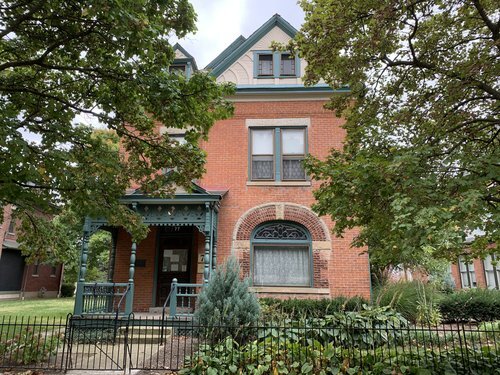 The windows on the top floor were to my room.
The windows on the top floor were to my room.Some of the stories James Thurber wrote were based on things that actually happened in this house—including “The Night The Ghost Got In.” Many of the past Writers In Residence had their own ghost encounter. Since my novel The Girl Behind The Glass is about a haunted house, I expected that I would too.
But I didn’t. I slept undisturbed. I heard no thumps. I felt no cold breezes. As a writer I've learned that you can’t always wait for inspiration to pay you a visit. Sometimes you must be brave and go look for it. Especially if it is something disturbing. So one night, I did. I waited until dark. I turned off all the lights. With only the faint glow of my cell phone, I crept down the same stairs where James Thurber had heard the thumps almost a hundred years ago. All my senses were alert. But I didn’t see or feel anything. And then, as I turned the corner and stood upon the bottom step, I saw something glowing beneath the dining room floorboards.
I waited until dark. I turned off all the lights. With only the faint glow of my cell phone, I crept down the same stairs where James Thurber had heard the thumps almost a hundred years ago. All my senses were alert. But I didn’t see or feel anything. And then, as I turned the corner and stood upon the bottom step, I saw something glowing beneath the dining room floorboards.
 I gasped and grabbed the newel post. I seemed to see the light pulse. Or maybe I was the one who was trembling?
I gasped and grabbed the newel post. I seemed to see the light pulse. Or maybe I was the one who was trembling? As I leaned closer to take this photograph, I realized what it was. Someone had left the light on in the basement.
Jane Kelley is haunted by many of the other characters she created, including the ghost in The Girl Behind the Glass.
October 4, 2022
Beyond Science Fiction: Teaching Science Through Fiction (Patty Mechael)
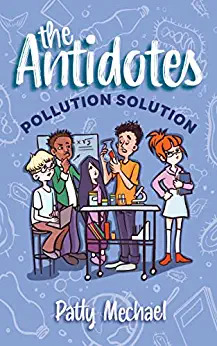 Growing up there was the general view that there are educational swim lanes. Kids who were good at math and science, like me, did not belong in the language arts and history lanes and vice versa. This was carried forward in the early focus to get more girls into Science, Technology, Engineering and Math (STEM). But thank goodness for whoever had the wisdom to expand it to include art and make it STEAM. As someone, growing up in New Jersey in the 1980s, who was both creative and gifted in STEM, I had very little exposure to the merging of art in my educational experience in STEM. And then in college, I took what is still one of my favorite educational experiences to date, a seminar course called African Politics through Fiction. Each week, we would read a novel by a prominent African writer that illustrated the political situation and cultural context a country. At the start of each class, the South African professor would provide an overview of the politics of the country and then launch us into the equivalent of a book club discussion. As someone who has spent much of the last 25 years working in public health in over 20 countries in Africa, it was an amazing and entertaining way to quickly immerse and orient myself to them.
Growing up there was the general view that there are educational swim lanes. Kids who were good at math and science, like me, did not belong in the language arts and history lanes and vice versa. This was carried forward in the early focus to get more girls into Science, Technology, Engineering and Math (STEM). But thank goodness for whoever had the wisdom to expand it to include art and make it STEAM. As someone, growing up in New Jersey in the 1980s, who was both creative and gifted in STEM, I had very little exposure to the merging of art in my educational experience in STEM. And then in college, I took what is still one of my favorite educational experiences to date, a seminar course called African Politics through Fiction. Each week, we would read a novel by a prominent African writer that illustrated the political situation and cultural context a country. At the start of each class, the South African professor would provide an overview of the politics of the country and then launch us into the equivalent of a book club discussion. As someone who has spent much of the last 25 years working in public health in over 20 countries in Africa, it was an amazing and entertaining way to quickly immerse and orient myself to them.
When I began writing The Antidotes: Pollution Solution with my now 10-year-old son, Gabriel, I wanted to create a book and experience that was realistic, scientifically accurate, educational, and entertaining. I did not want to write science fiction or fantasy, but science-inspired fiction. My vision for the book was that it would be used by science teachers and librarians to engage kids in multidisciplinary dialogue about the bridging of science and art, while teaching basic scientific and public health principles like water quality testing and plotting results on a graph. In the book, one of the two narrators, Izi, struggles with her love of science and her passion for singing and performing arts. Can she do the two together? And can she use her art to make the science more accessible and fun?
In the writing and revision process with the help of more seasoned middle grade fiction writers, like Caela Carter, I learned that I first needed to entertain and then make sure that the science was correct. There was also some debate about whether to include science experiments and/or illustrations to accompany the experiments. I am very pleased that we included both as another example of the importance of merging science and art. The way that I think the book will work best if for kids and teachers to read the book independently at home over a period of a month and to have weekly book club discussions about the story and complementary opportunities to run the experiments in science class alongside the characters in the book.
One important theme for discussion includes the benefits of diversity and teamwork in the sciences as well as the arts and in the intersection of the two. In The Antidotes: Pollution Solution, Gir, the male narrator, must come to grips that Izi is better at science than he is and that’s a good thing. Drawing on my own experience as a female scientist, kids need to learn how to collaborate in the sciences across genders and races so that scientific initiatives are more representative of who we are as a society. And they need to engage across disciplines to bring creativity into the sciences. In the words of Albert Einstein, “The greatest scientists are always artists as well.”
~
Dr. Patricia (Patty) Mechael is a mom, writer, and public health specialist; who combines her passions for public health, women’s rights, technology, science, and the world to inspire children and adults through her writing. Drawing on her career in global health, Patty’s works wrestle with the toughest public health and societal issues of our time, including the environment, responsible technology and AI, pandemic preparedness and mental health. Her writing also draws on her more than20 years of work across more than 40 countries in Africa, Asia, and Latin America. Patty holds a PhD in Public Health and Policy from the London School of Hygiene and Tropical Medicine and a Master’s in Health Science in International Health from the Johns Hopkins School of Public Health. She is the author of the middle grade fiction novel, The Antidotes: Pollution Solution (October 4, 2022), which she wrote with her 10-year old son (available for pre-order on Amazon).
October 3, 2022
Ghosts of AFRICAN TOWN by Irene Latham and Charles Waters
 G.P. Putnam's Sons/
G.P. Putnam's Sons/Penguin Random HouseAFRICAN TOWN is an historical verse novel told in 14 voices, about the Africans kidnapped and brought to America in 1860 aboard the Clotilda (known as the last American slave ship) and the home in Alabama they created for themselves, then called African Town (now known as Africatown).
It is also a ghost story in the sense that Charles and I were writing about real people whose stories haunt us, both breaking our hearts and inspiring us still today.
Our primary goal was to honor these ghosts and their descendants, and to tell a triumphant and truthful story.
Learn more this month when the documentary film DESCENDANT releases on Netflix. Here's the powerful trailer.
And here's a poem (with "ghosts") from the book in the voice of a young Yoruba woman, age 16 at the time of capture, who's just arrived in America after the tortuous overseas journey. Anything is made more bearable when one has a friend.
Thanks so much for reading!
ABILÈ
Landfall
When the sailors open the hold to let us out,
I run my hand along the scratches I’ve made
to mark the days. Ogójì. “Ogójì,” Kêhounco confirms.
We’ve been on the Clotilda for forty days.
My legs tremble as we climb the stairs. What will we see?
For a moment the ghosts I left behind swirl around me,
but I push them back. They are of no use to me here.
They would only weigh me down.
I reach for Kêhounco’s hand, for what’s real. Her fingers
are warm in mine, even though now we can’t offer
each other much more than bones. Whatever fate awaits us,
we will face it together. Just as we have done all along.
----Irene Latham is a grateful creator of many novels, poetry collections, and picture books, including the coauthored Can I Touch Your Hair? Poems of Race, Mistakes, and Friendship, which earned a Charlotte Huck Honor, and The Cat Man of Aleppo, which won a Caldecott Honor. Irene lives on a lake in rural Alabama.
October 2, 2022
Ghosts!
Ghosts! They’re definitely an October theme. So I thought I’d share some middle grade novels featuring ghosts. On my (other) blog, Book Q&As with Deborah Kalb, I interview a wide variety of authors, including some who write ghostly tales.
One of those authors is Charis Cotter, and back in November 2018 I interviewed her about her middle grade novel The Ghost Road, which features twins, family curses, and, of course, ghosts. Cotter told me: “Early in my thinking about the story, I imagined a ghost coming into the girl’s bedroom carrying a candle, and the story just went on from there. My mother’s family is from Ireland, and I have a strong sense of my female Irish ancestors and the burdens of shame and guilt that get passed down in a family. All of this influenced my story.”
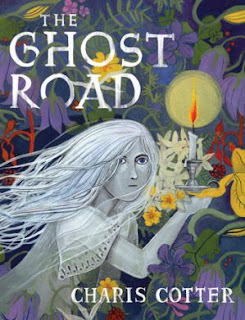
In December 2020, I interviewed Dianne K. Salerni about her middle grade novel Eleanor, Alice, and the Roosevelt Ghosts. This book focuses on cousins Eleanor Roosevelt and Alice Roosevelt (later Longworth), and a menacing ghost in their house. Salerni said: “I had been toying for a long time with an idea for an alternate reality where ghosts were real and so prevalent that a scientific discipline had developed to ‘diagnose’ them into categories: Friendly, Unaware, or Vengeful. I wanted to write a story that centered around a ghost that was misdiagnosed and more dangerous than it first appeared.”

Then there’s Ghosted, by Michael Fry, in which a boy’s best friend returns as a ghost. I interviewed Fry in January 2021, and he said, “It’s tricky when you’re dealing with a deceased character. The question I asked myself was how would two real-world human boys react to this extraordinary situation. It’s a weird situation that sets up a lot of conflict. And conflict is the basis for humor. No conflict. No comedy.”
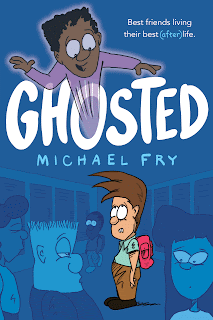
And last but not least, we have Noah McNichol and the Backstage Ghost, by Martha Freeman, whom I interviewed in March 2021. The story centers around a school play, and Freeman told me: “My friend Samantha, who is a high school drama teacher, posted a plea on Facebook for a volunteer to help her with an upcoming production. I had recently framed an old photo of my dad and my uncle working on a college production of Blithe Spirit, and I thought to myself, ‘Oh, it’s too bad my father is dead. He would have loved to help Samantha.’ Then I thought, ‘Hmmm, what if a ghost did help out with the school play?’ And bingo – I knew I had my next book. After that, it was just working out details.”
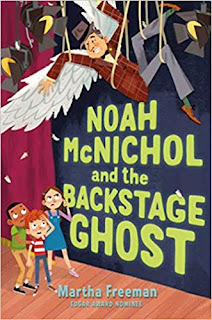
Of course, this is just a sampling of the amazing ghosts that appear in middle grade literature. But it’s a good start.
--Deborah Kalb
@font-face {font-family:"Cambria Math"; panose-1:2 4 5 3 5 4 6 3 2 4; mso-font-charset:0; mso-generic-font-family:roman; mso-font-pitch:variable; mso-font-signature:3 0 0 0 1 0;}@font-face {font-family:Calibri; panose-1:2 15 5 2 2 2 4 3 2 4; mso-font-charset:0; mso-generic-font-family:swiss; mso-font-pitch:variable; mso-font-signature:-536859905 -1073732485 9 0 511 0;}p.MsoNormal, li.MsoNormal, div.MsoNormal {mso-style-unhide:no; mso-style-qformat:yes; mso-style-parent:""; margin:0in; mso-pagination:widow-orphan; font-size:16.0pt; font-family:"Times New Roman",serif; mso-fareast-font-family:Calibri; mso-fareast-theme-font:minor-latin;}.MsoChpDefault {mso-style-type:export-only; mso-default-props:yes; font-size:16.0pt; mso-ansi-font-size:16.0pt; mso-bidi-font-size:16.0pt; mso-fareast-font-family:Calibri; mso-fareast-theme-font:minor-latin;}div.WordSection1 {page:WordSection1;}
September 28, 2022
Words of Gratitude...
By Charlotte Bennardo
My favorite teacher? It's a tie between my seventh grade and senior high school English teachers; Mr. Cavuto and Mr. Grattan. I admired them so much, I dedicated Blonde OPS to them:
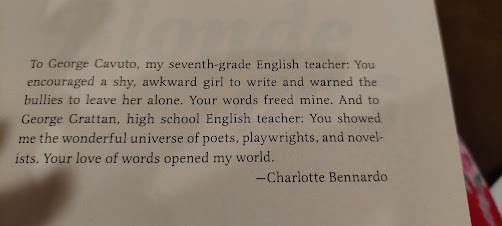
I can think of no higher expression of my respect for them, and gratitude for educating me.
I reached out to them, but sadly, Mr. Grattan had passed. His wife and children were thrilled when I sent a signed copy to them and thanked me. I met up with Mr. Cavuto about two years ago. He became a university professor after leaving my junior high school and then a literacy specialist, and is still working as far as I know.
When someone influences your life so profoundly that it changes your life and you'll never forget them, saying 'thank you' is too paltry. So I put my gratitude and thanks into words- and I think they'd appreciate that more than hearing it.
Charlotte writes MG, YA, NA, and adult novels in sci fi, fantasy, contemporary, and paranormal genres. She is the author of the award-winning middle grade Evolution Revolution trilogy, Simple Machines, Simple Plans, and Simple Lessons. She co-authored the YA novels Blonde OPS, Sirenz, and Sirenz Back in Fashion. She has two short stories in the Beware the Little White Rabbit (Alice through the Wormhole) and Scare Me to Sleep (Faces in the Wood) anthologies. Currently she is working on several novels for both children and adults, and her MFA. She lives in NJ with her family and her floofy cat. When they trimmed the backyard tree, the crazy squirrel couple had to move out.
September 25, 2022
Dr. Burling Was Pretty Awesome - Holly Schindler
Fave teacher of all time. Seriously. Dr. Burling, professor of lit at what was then Southwest Missouri State University. (Now MSU). He was kind of a skinny guy, gray hair and a beard, wire glasses. Every time I saw him, I could hear that line from the Indigo Girls song. The one about going to see the professor of philosophy--with a poster of Rasputin and a beard down to his knee.
He taught my intro to literary theory class. The one that introduces you to all the critical theories and approaches. New Criticism. Reader Response. Feminist or Marxist interpretations.
I had no idea what I was doing. And he knew it.
I started out really hating the guy. He drove me nuts. I wrote and rewrote every paper that was assigned. And grumbled about it every step of the way.
And then, somewhere in the middle of the semester...things started to change. I started showing up in his office to talk about my papers. And I started to click with what he was talking about. Finally.

Once I started to get it, I started to warm to the guy. We talked about music (he played guitar and wrote songs, as did I). We traded tapes of our original stuff (yeah, it was the mid-'90s). I wound up taking four different courses with him--including a sci-fi course. When I got a piece accepted in The Explicator--an exploration of a Howard Nemerov poem using the same critical theories that had once driven me crazy--I brought a copy to his office. He had me sign it and said, "One of these days, I'm going to point to a book and say, 'She was in my class.'"
It was the greatest moment of college.
When I got my first book accepted, I immediately looked up Dr. Burling--only to discover he had passed away about two months prior.
I still think often of Dr. Burling. Of his patience with a nineteen-year-old kid who grumbled about the paper she was being asked to rework for what felt like the five thousandth time. Of refusing to let me take the easy way out--not with a paper, and not with a single sentence. Of his music and his kindness. I especially think of him when I'm revising.
What's the best compliment you can pay a teacher? Sometimes I think that it's that they left a thumbprint. That you can feel it, the mark they made, decades later. I hope it is. Because that's how I feel about Dr. Burling.
~
Holly Schindler is the author of The Junction of Sunshine and Lucy, an MG on classism and beauty and folk art. It was nominated for a Mark Twain Award. Schindler wished she could tell Dr. Burling about that, too.
September 23, 2022
There’s a Mystery There: Smack Dab in the Imagination by Dia Calhoun
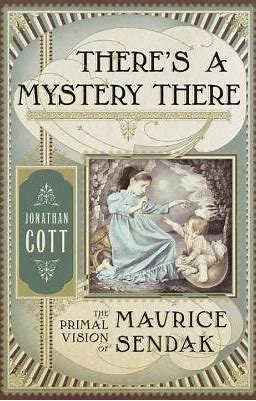
A feast, a joy, the book There’s a Mystery There: The Primal Vision of Maurice Sendak is beautiful in both content and form. Turning the thick, beautifully printed and illustrated pages is a delight in this age of screens. Author Jonathon Cott explores Sendak’s work but focuses on my personal favorite Outside Over There.
In one chapter, Cott speaks with Tony Kushner who makes a revelatory comment about imagination: “...all great artists aspire to pare away and make everything essential and make everything count, but that sort of Beckittian idea of boring down to the smallest thing and stripping everything away isn’t all there is in Maurice’s work. I can understand why he admired people who attained a maximum meaning with a minimum of means, but there’s an effusiveness in Maurice’s imagination that’s slightly at odds with that classical idea, And I think he never lost his appetite for the super abundant and excessive.” (Page 210)
For me, this juxtaposition of the essential with effusiveness is what creates the most vital art. Consider this passage about genius from The Norton Anthology of English Literature, Third Edition which expresses a related idea: “…Chaucer, Spenser, and Shakespeare, who catch “a grace beyond the reach of art”: that ultimate inexpressible charm which converts the merely formal and regular into vital and animated beauty.” (Page 2432)
Often, that odd thing--that character, action, or twist--that comes flourishing in from your imagination from god-knows-where and breaks the careful pattern or structure you have developed, is what makes your story or poem come alive. Be brave enough to open the door. Genius could be waiting.
What is the knocking?
What is the knocking at the door in the night?
It is somebody wants to do us harm.
No, no, it is the three strange angels.
Admit them, admit them.
D.H. Lawrence.Song of a Man Who Has Come Through (last five lines)
September 19, 2022
Writing Hope to Young LGBTQIA Audiences by Benjamin Klas
 When I came out of the closet, I was the only queer person that I knew – outside the pages of the precious few books I smuggled into my bedroom. The predominant literary themes framed the experience of LGBTQIA individuals as inevitably sad and hurtful to people around us. Those stories led me to believe that isolation and guilt were simply the fate of all queer folk. Fun, right?
When I came out of the closet, I was the only queer person that I knew – outside the pages of the precious few books I smuggled into my bedroom. The predominant literary themes framed the experience of LGBTQIA individuals as inevitably sad and hurtful to people around us. Those stories led me to believe that isolation and guilt were simply the fate of all queer folk. Fun, right?Here’s the thing: we don’t have to ignore the dark parts of the experience, but let’s also provide our readers with some of the brilliantly sparkling facets of LGBTQIA life.

Maybe I’m getting ahead of myself. Sorry. You’re probably wondering who the heck is talking to you. My name is Benjamin Klas (he/him), the middle grade author of Second Dad Summer, and its sequel, Everything Together: a Second Dad Wedding. They are stories of finding family of choice and experiencing the joy of authenticity within the LGBTQIA community. Why did I write these books? Because I wanted to present hope to young readers of all types, but specifically kids who are gender or sexual minorities.
For those of you who can’t remember the pantheon of words in the acronym, here’s a quick refresher on what LGBTQIA typically stands for:
Lesbian
Gay
Bisexual
Transgender
Queer/Questioning
Intersex
Asexual/Aromantic
Obviously these letters can’t cover the full spectrum of identity, but it gives a feel for the scope of this community without listing off half the alphabet. If you’re not familiar with any of these terms or want to know more, I would highly recommend using that little magic box: Google. In this article, for the sake of simplicity, I will be using the blanket term ‘queer’ to refer to people in the gender and sexual minority.
Okay, here we go. Get ready for some abbreviated thoughts on diversity, trying to look beyond the coming-out narrative, writing robust identities, celebrating physical touch, and finding community. As much as I’d love to write about these things forever, I’ll keep it down to the length of a blog post. For a more comprehensive perspective, please await the 14,987 page version I’ve been meaning to get around to writing.
Let’s talk about diversity. If I have to slog my way through another book where the queer love interest has to be a gorgeous sports player (inevitably white, male and cisgendered), I’m going to have an aneurysm. I don’t know whether you’ve ever noticed that literature as a whole tends to focus on the experiences of white, able-bodied, neurotypical individuals, but the real world is a vibrantly varied, multi-textured, kaleidoscopic place. And yes, that’s even true in the queer community. We embrace a veritable garden of pronouns. We are fat and thin and ripped and scrawny. We are all colors that people come in. You can find us on every continent, including Antarctica (I mean, come on, even penguins can be queer). We use wheelchairs. We are on the autism spectrum. So don’t burden your readers by telling them that to be queer, you have to be thin, conventionally “beautiful,” and white.
When you include some of those deliciously diverse queer characters in your book, they have to come out of the closet, right? Believe it or not, people are queer before coming out of the closet, while coming out, and we’re still queer forever after coming out. Telling coming out narratives is important, but it’s just as important to tell the stories before and after this process. Your queer character doesn’t have to come out in the novel. Maybe they don’t feel safe doing that right now. That’s okay! And it doesn’t mean they have to live sad little existences fraught with self-loathing. Maybe they’ve been out and proud for seven years before your novel even takes place. That’s great, too! What’s not okay is reducing the value of their queerness to whether or not they’ve taken the step of coming out. Let your readers know that wherever they are in the process of identity formation, it’s okay. We’re all on a journey.
As you write queer characters moving along whatever journey is before them, take a long think about their identity beyond just being the token queer character. Although this may come as a shock, we queer people aren’t only defined by our sexual or gender identities. At some points, our sexual or gender identities might be front page 1000 point font headlines in our lives, but nobody is totally defined by any one characteristic. We queers have hobbies besides just “being queer,” acting as LGBTQIA encyclopedias for all the straight characters, or checking off another box on the diversity quota. Gifting a character with a queer identity doesn’t mean you need to sacrifice their role as the Dungeon Master of their D&D group, abandon their interest in herpetology, take away their obsession with monster trucks, or surrender their spot on the cheer squad. Give them hobbies and interests. And, oh gawd, those hobbies DON’T have to be fashion and Broadway. Straight characters aren’t reduced to their straightness. Neither should queer characters be reduced to queerness!
Now that your characters are getting nuance in their personas, let’s talk about their physiological selves. Many of us in the queer community have been told explicity and implicity that what we feel in our bodies is either perverted or simply imagined. Society has labeled our bodies and our touch as somehow tainted. Many of the books I’ve read either hypersexualize everything queer people do, or completely desexualize them to make them feel more comfortable for conservative readers. Let’s see some characters who grow to know and understand their bodies as awesome physical extensions of themselves – who are able to inhabit their sexuality, gender experience, and need for physical touch. As strange as this is going to sound, let your queer characters touch each other! And no, not just in that way. Let them hug, pick earwax out of each other’s ears, snuggle, walk with their arms around each other. And no, this does NOT have to be relegated to just romantic interests. Friends, family, and yes, lovers, all deserve to share physical touch. Let’s show people who aren’t physically toxic, whose touch is not twisted or a threat to other queer or straight characters.
Speaking of letting characters experience physical contact, let’s talk more about who that can be with. Too often, characters come out of the closet and meet one other queer character – the love interest. And that’s it. Queer adult characters in same sex relationships are often only surrounded by other straight adults. Again, isolation is the theme. But the story doesn’t have to end there. One of the greatest parts about being queer is the sense of community you can find, especially with the connective powers of social media. Finding other people with shared experiences. Starting to build your family of choice. Forming clubs in school. Finding “your people” as young people or adults. We queers have always found a way to locate each other to support and challenge and fall in love and be authentic with one another. Show young readers that side of the queer experience, too.
So there you go. Hopefully that gives you a few ideas for writing awesomer queer stories for young people. Let them see reflections of their experiences and windows into the experiences of others. Show them that who they are and where they are on their journey is powerful and bright and wonderful. Give them characters whose identities aren’t stripped down to only their sexual or gender orientations. Bring out physical touch. Let them know that they are not alone. Fabulous things await them.
Get to that keyboard.
Write.
Write hope.
~
Keep up with Benjamin Klas at his author site and follow on Twitter.
September 18, 2022
A Conversation with Alda P. Dobbs, Author of The Other Side of the River + Giveaway!
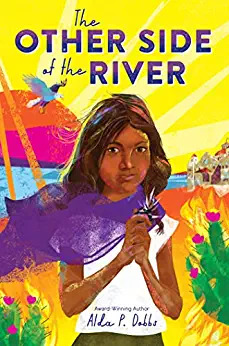
Holly Schindler here, administrator of Smack Dab in the Middle. When I got the ARC for The Barefoot Dreams of Petra Luna, I knew, just a handful of sentences in, that I was reading something really special. And I was utterly thrilled to get my hands on the sequel, The Other Side of the River. Alda P. Dobbs was kind enough to join us for a second chat:
HS: Hey, Alda! You know I’m a serious fan of Barefoot Dreams, the first installment of Petra’s story. I immediately tore into The Other Side of the River. It was as though Petra and I had never been apart! How’d you tap back into the tone of her voice?
AD: It’s a pleasure to be here with you doing a second interview! Very interesting question. The idea of writing my great-grandmother’s story came to me after my first completed manuscript went nowhere. At that time, I thought I’d give children’s magazines a shot. I published an article for Highlights Magazine and when they requested a second one, I considered writing about my family’s story. It took me almost two years to verify that indeed my family’s story was true, and at that point I decided to turn the article into a picture book. Thanks to the advice of an agent during a conference, that picture book morphed into two novels. But the picture book I had written, ended up being the opening chapters of The Other Side of the River! So, Petra’s voice was born in that picture book.
HS: Petra’s story in Barefoot Dreams is based to a great extent on your own family history. But the second book diverges pretty significantly from your family story. Can you talk a little about the inspiration and why you decided to deviate a bit here?
AD: My great-grandmother talked about the time when the refugee camp she was living in was about to be shut. She described how refugee families were given the option to return to Mexico (the federales were no longer a threat) or remain in America. The US government would aid refugees in finding work and housing if they decided to stay. My great-grandmother, who was nine years old, motherless, and the oldest sibling, talked it over with her father and both decided to return to Mexico. After all, Mexico was their homeland and they wanted to help restore her. In my research, I found out that many Mexicans returned home, and yet over two million Mexicans made America their permanent home. With this in mind, I wondered how my great-grandmother’s life and that of her descendants would have differed had she remained in America. I also wanted Petra Luna to see her new country with the same eyes my mother and I saw it as immigrants.
HS: This might piggyback on your answer above, but there are so many topical issues in this book, even though it’s historical fiction—but that’s when historical fiction is at its best! It puts a mirror in our modern-day faces. I see connections with small pox / Covid, as well as our current immigration debates. Is that part of the reason you wanted to follow Petra up in the US rather than Mexico?
AD: It's funny, but I never realized how similar these two periods were until I began doing the research. I placed Petra in the U.S. following the thought of “what if” and later realized how much history repeats itself. That’s why I urge readers, especially young ones, to capture family stories and discover their parallels in history and cultures.
HS: Which was more difficult—writing the first book or second? How so?
AD: Both had their moments of “Oh, my goodness, what am I doing??” but in the end, I’d have to say the second was a teeny bit more difficult because for the first time I had a real, one-hundred percent genuine deadline – with a capital “D” – hanging over my head. It makes a big difference when it’s a self-imposed deadline versus one where a whole team is waiting for your story.
HS: With two books under your belt, has your approach to historical fiction changed?
AD: I’d say I feel more confident about research. Having a physics and engineering background, I used to approach research in a totally different manner which was very inefficient for writing purposes. I now know where to go and I’m not afraid to approach librarians. I’ve discovered that they’re amazing, wonderful people who are eager to help J
HS: Did you find it hard to write family history? Everyone has their own memories or versions of events. What was the family response to Barefoot Dreams?
AD: Some of the scenes were difficult to write because I knew they had really happened to my family and at times it was difficult to process the pain and anguish they must have felt under those circumstances. On the bright side, I’ve had extended family members thank me because many of the family stories had been lost and my book helped reignite that passion and curiosity for our past. Now they’re able to share our stories with the next generation. Personally, I’m still waiting for my mother to read it. She only speaks Spanish, and it really bothers her (and me!) that she can’t yet enjoy it. BUT a little bird told me that the Spanish version may be coming out soon….
HS: I had to tell you my favorite passage: “A strange thing happens when a country fights itself. There are no winners or losers. One side may claim victory, but in the end, it’s a loss for everyone. It’s like two parts of a single body fighting each other. If the head claimed victory over the feet and destroyed them, then the body could no longer walk to explore and find a better place. If the feet destroyed the head, then the body could no longer think nor plan for a better future.” I find this so timely. Do you have a favorite passage?
AD: Aww, thank you, Holly. Timely is a perfect word for it. One of my favorite quotes is from a hunched-back woman, also a Mexican refugee, who is selling tacos in the street when Petra first arrives in San Antonio. As the old woman holds the coins a customer just paid her, she shows them to Petra and says, “This here is opportunity…and opportunities are everywhere in America…but opportunities don’t fall from the sky like rain…They only come to you when you work hard.” I like this quote because as an immigrant, I have received so much from the U.S., my adoptive land, but the many doors that have opened for me – studying physics, being in the military, living overseas, writing a book – are amazing opportunities that took a lot of work and perseverance. The beauty, though, is that these opportunities were within my reach, they existed. I believe that despite America not being a perfect country, it’s still one of the best places in the world.
HS: Has your perspective on your great-grandmother changed since spending so much time with Petra?
AD: It has. I admire her so much more and value her legacy. I also admire the passion my mother has for sharing family stories that have shaped me in many ways.
HS: What do you most want young readers to take away from these books?
AD: I want them to realize that Petra’s story is not unique to my family or to Mexicans. It’s a universal story that transcends periods and cultures. Avi’s book Crispin shows a character whose life very much resembles Petra’s, yet both worlds are completely different. I also want them to realize the immense strength they carry within. Like Petra Luna, they too are fighters, warriors, survivors. They too have the same courage.
HS: What’s next?
AD: I am working on another historical fiction that is set in a different time but maybe the same place? Stay tuned!
As always, thank you, Holly, for these amazing questions!
~
The Giveaway! One copy of The Other Side of the River. Simply comment below to enter. Giveaway ends 9/25!
September 16, 2022
A Library Destiny?
 It may be that it was always my destiny to be a librarian. During my senior year of high school, when I was allowed to choose an aide position for my free period, I chose to help out Ms. Dowling in the library. Our school - in typical small-town Alaska style - included elementary and high school in the same building, so the library served all ages.
It may be that it was always my destiny to be a librarian. During my senior year of high school, when I was allowed to choose an aide position for my free period, I chose to help out Ms. Dowling in the library. Our school - in typical small-town Alaska style - included elementary and high school in the same building, so the library served all ages. It was well before the time of computerized record keeping, so we had an old-school card catalog. Books were checked out using the cards and pockets in the back, and part of my job was helping a second-grade class check out their books, filing the cards away, and then uniting the returned books with their filed card. If a student needed to do research, there were encyclopedias, magazines, and those good old-fashioned microfiche machines for archival materials. In addition to checking books in and out, I shelved books and did other organizational tasks. It was a quiet, orderly world, and I loved it.
And yet, when I went away to college, it never occurred to me to choose the library as a career path. I don't think I was aware that it was something you could even choose, or if library science was even offered at my university. I never checked. I was going to be a wildlife biologist, or a veterinarian. Over time, school wore me down and I lowered my sights from the demanding sciences, eventually ending up with a business management degree, nowhere near the biology field or my beloved library. So I worked in a medical office, then had a bunch (read: five) of kids and stayed home with them for a decade. And when I finally re-entered the work force, the school seemed a logical choice. After all, I was there all the time dropping kids off, picking them up, attending functions. I got a job as a part-time kindergarten aide, which eventually morphed into a full-time reading and math tutor position.
In the meantime, I also put in a few hours helping the librarian. She was impressed by my children's literature knowledge and encouraged me to pursue an elementary librarian position. Actually, I can almost say she badgered me into it (thanks, Nikki!). In our district, a Master of Library Science is not required for the elementary positions, but a basic library science course and an intensive children's lit course are. I took those required courses, and (humble brag) I got an A+ on my final paper for children's lit. At last, I was in my element.
I applied for two positions in the school district, before I finally got the third one. The first library that didn't hire me later had its roof collapse, and the second one closed when the district had to choose a couple of schools to shut down, so obviously, I'm some sort of a witch! (We won't talk about the ice storm, clogged drain, and shower of water and ceiling panels that took out my circulation computer last December because clearly that was just an act of nature)
 First day of school, my first yearLooking back to August of 2013, when I walked into the library I would be running, I immediately felt at
First day of school, my first yearLooking back to August of 2013, when I walked into the library I would be running, I immediately felt athome. That's not to say that a lot of hard work, adjustments, and changes haven't been necessary over the decade I have worked there. I've grown myself and grown my library in many directions. But as a whole, I'd say I feel most like myself at work. I am comfortable and confident in teaching kids about libraries and literature, and putting just the right book in the right child's hands feels like my life's work. I can't imagine a more fulfilling job.
So, was it just luck that made me pick being a library aide way back when I was a seventeen year old schoolgirl? I'm not a big believer in predestination, soulmates, meant-to-be, and that sort of thing. I've always felt life proceeds based mostly on effort and chance. But I do firmly believe that, for me, I have found the most perfect role in life, as a school librarian, and I can't believe they actually pay me for it! The library is the heart of any school, and being at the living, breathing heart of this educational world feels like a dream.



